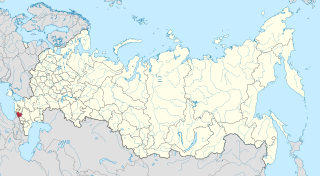The South-East (Russian : Ю́го-Восто́к), also referred to as South-Eastern Krai (Ю́го-Восто́чный край) and South-Eastern Oblast (Ю́го-Восто́чная о́бласть) was a territory, and later an administrative division, of the Russian Soviet Federative Socialist Republic (RSFSR) which existed in 1920-1924.

Russian is an East Slavic language, which is official in the Russian Federation, Belarus, Kazakhstan and Kyrgyzstan, as well as being widely used throughout Eastern Europe, the Baltic states, the Caucasus and Central Asia. It was the de facto language of the Soviet Union until its dissolution on 25 December 1991. Although, nowadays, over two decades after the breakup of the Soviet Union, Russian is used in official capacity or in public life in all the post-Soviet nation-states, as well as in Israel and Mongolia, the rise of state-specific varieties of this language tends to be strongly denied in Russia, in line with the Russian World ideology.
A krai or kray was a type of geographical administrative division in the Russian Empire and in the Russian SFSR, and it is one of the types of the federal subjects of modern Russia.
An oblast is a type of administrative division of Belarus, Bulgaria, Kazakhstan, Kyrgyzstan, Russia, Ukraine, and the former Soviet Union and Kingdom of Yugoslavia.
Contents

Originally, the name "South-East" was used informally to refer to the territories of Don, Kuban-Black Sea, and Terek Oblasts, as well as those of Stavropol Governorate and Dagestan ASSR, which were governed by the Revolutionary Soviet of the Laborers' Army of South-East Russia (hence the name "South-East") established on August 7, 1920. While the Soviet itself was abolished in 1921, the name "South-East" stuck. Occasionally, the territory was also referred to as "South-Eastern Krai" and "South-Eastern Oblast", even though no official krai/oblast status was assigned to it at the time.
Kuban Black Sea Oblast was an administrative division of the Russian Soviet Federative Socialist Republic which existed in 1920–1924.

The Terek Oblast was an oblast (province) of the Caucasus Viceroyalty of the Russian Empire. It roughly corresponded to most of present-day northeastern Caucasus. It was created out of the former territories of the Caucasian Peoples.

The Stavropol Governorate was a governorate (province) of the Russian Empire. It roughly corresponded to most of present-day Stavropol Krai. It was created in 1847 out of the territories of Caucasian peoples and disbanded in Russian SFSR in 1924.
The system of the administrative and territorial division of the RSFSR was developing haphazardly in the beginning of the 1920s: it was inconsistent, expensive to maintain, and not very effective in practice. As a reaction to that, the 12th Congress of the Russian Communist Party (Bolsheviks) on April 23, 1924 decided to test a new system of the administrative division in two experimental areas: one industrially developed and one agricultural. The South-East became a testing ground for the new system in the agricultural area. On February 13, 1924, the All-Russian Central Executive Committee (VTsIK) officially defined the South-East as the area comprising the territories of Don and Kuban Oblasts, Terek and Stavropol Governorates, the city of Grozny, and Kabardino-Balkar, Karachay-Cherkess, Adyghe-Cherkess, and Chechen Autonomous Oblasts [1] and mandated its division into districts ( raions ) by the end of 1924. On June 2, 1924, the Presidium of the VTsIK established a list of the new okrugs and districts into which the "South-Eastern Krai (Oblast)" was to be divided. At the same time, Kuban-Black Sea Oblast was abolished and replaced with four new okrugs, which were further divided into districts by the Executive Committee of Kuban-Black Sea Oblast on July 19, 1924.

The 12th Congress of the Russian Communist Party (Bolsheviks) was held during 17–25 April 1923 in Moscow. The congress elected the 12th Central Committee. It was attended by 408 delegates with deciding votes and 417 with consultative votes, representing 386,000 party members. This was the last congress of the Russian Communist Party (Bolsheviks) (RCP during Vladimir Lenin's leadership, though Lenin was unable to attend due to illness. Much of this Congress was taken up with Joseph Stalin's struggle against the Georgian Bolshevists. Stalin dominated the Congress with Grigoriy Ordzhonikidze and Mamia Orakhelashvili, moving against the Old Bolsheviks Budu Mdivani and Filipp Makharadze. Stalin accused the latter of the following:

The All-Russian Central Executive Committee, was the highest legislative, administrative, and revising body of the Russian Soviet Federative Socialist Republic from 1917 until 1937. Although the All-Russian Congress of Soviets had supreme authority, in periods between its sessions its powers were passed to VTsIK.

Grozny is the capital city of Chechnya, Russia. The city lies on the Sunzha River. According to the 2010 Census, it had a population of 271,573; up from 210,720 recorded in the 2002 Census, but still only about two-thirds of 399,688 recorded in the 1989 Census. It was previously known as Groznaya.
South-Eastern Krai was renamed North Caucasus Krai by the Resolution of the Presidium of the VTsIK of October 16, 1924 and by the Resolution of the Krai Executive Committee of November 16, 1924.

North Caucasus Krai was an administrative division (krai) within the Russian Soviet Federative Socialist Republic of the Soviet Union. It was established on 17 October 1924. Its administrative center was Rostov-on-Don until 10 January 1934, Pyatigorsk until January 1936, then Ordzhonikidze and, from 15 December 1936, Voroshilovsk.









